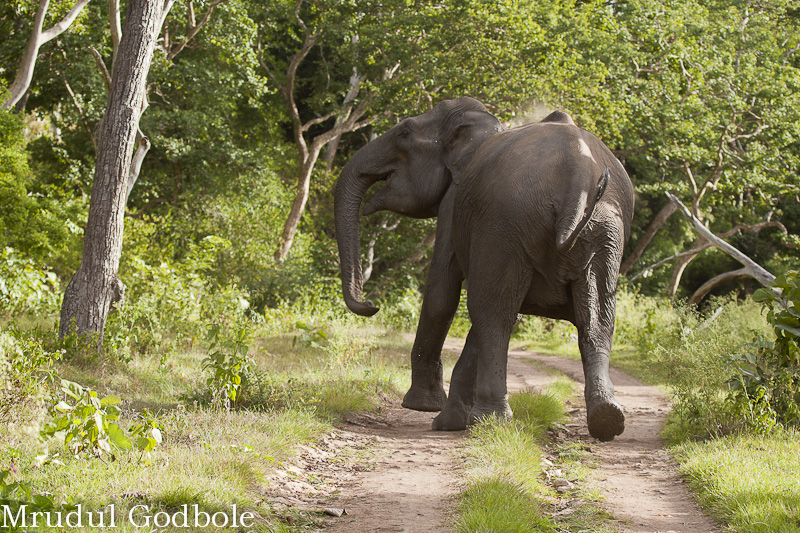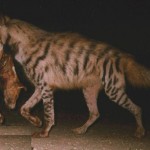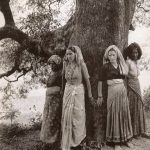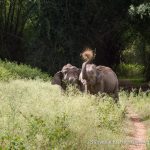The Asian Elephant – A Natural History
by J. C. Daniel
There have been several good books on the Asian elephant written from different perspectives with detailed emphasis on certain aspects. This book on the Asian elephant is a splendid compilation of reports of various naturalists and hunters published in the Journal of the BNHS as well as several research studies.
The book is divided into various chapters detailing the past and present distribution of Asian elephants, their population, colour and size, habits, behaviour, breeding, growth, age, diseases, interaction with man etc.
Like his other compilations on mega-fauna like the Leopard and Tiger, this book on the Asian Elephant too gives us a sneak peak into a bygone era.
By virtue of the detailed statistics, notes and anecdotes, this book will not only act as a fine reference book on elephants, but also help naturalists and other people venturing into the jungle learn some very important learnings which will not only help in understanding the behaviour of these gentle giants but also can be life saver.
In this book review, I have chosen to glean and share a few interesting details which will help the reader to not only appreciate it but also crave for more.
Asian Elephant Vocalisations from M. Krishnans notes:
M Krishnans detailed note on elephant vocalisations contains observations that help a lot in understanding elephant behaviour.
Charging elephant: A charging elephant may come on in silence or utter a piercing, malevolent scream. (See opening shot of Wild India: Elephant Attacks)

When alarmed and on the point of bolting, the tail is thrown up and the head raised, with ears fanned out and then folded back, an attitude that serves effectively in visual communication of the alarm to other elephants around.
M Krishnan has succinctly summarised vocalisation by asian elephants. He says Some of the vocalisations of elephants are well-known, such as trumpeting, squealing, squeaking (the two terms are used to distinguish a louder sound of protest from a weaker and softer sound, usually of pleasure in elephants), roaring (usually indulged in by juvenile elephants of from one to five years, when separated from their mothers in the course of foraging), and a sudden metallic and at the same time tympanic sound made by rapping the trunk shapely against the ground (the sound seems to be produced mainly by the sudden percussion of the column of air in the trunk as it is expelled) which is a sound of apprehension and interrogation strictly speaking, not all of these sounds are vocalisations, since some are produced not in the throat but in the trunk”.
To hear the asian elephant vocalisation please click on the link here –
http://www.indiawilds.com/forums/showthread.php?13896-Elephant-Vocalisations
“Other vocalisations are less well-known and may be briefly set out here. One of these is a plaintive, reiterated kook-kook-kook, sounded when the animal suddenly discovers something that annoys it (such as the near presence of a man: it is a sound of protest, but I have also heard it used by an exceptionally burly tusker that was demonstrating to us, while covering the retreat of the herd (which we were following), evidently some form of communication with the herd. Very young calves (under 2 months) come out with a loud, quickly-repeated bark that is very like the barking of a dog (though louder and flatter); a sound that is known to very few mahouts, for it is not uttered by calves in elephant camps. It can be heard only from the calves of wild elephants, and seems to be an expression of exhilaration. Older calves do not indulge in this vocalisation.
A loud, repeated smacking, made with the lips, is commonly employed by the leading adult animals in a herd when the herd is on the move and somewhat uneasy over what lies ahead: an adult cow smelling at the rump of another adult cow was also heard coming out with this smacking sound. Frequently when the herd is grazing in the open (never in cover), the adults converge in a close circle, with their heads facing the centre, and seem to confer together; after such a conference, the animals usually move away steadily in one direction, keeping close together and not in loose formation as when grazing: I have never been able to get sufficiently close to elephants in conference to know whether or not they make any sounds then, but believe they do come out with some soft, low sounds-they certainly do indulge in tactile expressions with their trunks then. Among tame elephants, two cows may be seen standing close together, almost in a huddle, caressing each other with their trunks and coming out with throaty, hardly-audible sounds-this is especially noticeable when two cows that like each other meet after a separation.“
Tusk Disease & bad Temper
J. C. Daniel has also quoted S. K. Ghoshs observations about maggots in the tusks of elephants Every rogue I shot myself, and every other which was shot by others, and which I had the chance to examine, had undoubted need of a dentist for, at the root of the tusks of eah one of these animals, I found pounds and pounds of live maggots, which must have caused them excruciating agony. I am inclined to think that it is the tusk disease which makes them, young and old, so bad-tempered, and forces the others to kick them out of the herd. Whenever tracking a rogue or solitary I have noticed that the animal frequently thrusts his tusks through anthills, or soft saplings, and as I have never seen the marks of tusks thrust through in this manner when a herd has passed, nor have I seen our tame elephants doing this, I feel that I am not far wrong in holding that they do this in order to relieve the agony caused by the maggots far inside their jaws. R. C. Morris too supports this argument that elephants with tusk disease thrust their tusks on anthills or trees elephants with tusk disease do thrust the diseased tusk into ant-hills and young trees is correct. A broken end of a tusk, about a foot long, was brought to me some years ago, the Sholaga had found it wedged firmly into a tree, and Sir Frank Colyer, to whom I sent the tusk, expressed the opinion that the elephant had been suffering from toothache.
Elephant’s Trunk:
M. Krishnan notes When the animal is at peace with the world, the trunk swings freely and the ears flap from time to time; when the head is held high and movements are brisk, it is in high spirits. When undecided or perplexed, the tip of the trunk is sometimes inserted into the mouth or, in a tusker, the trunk is draped over the tusks and hangs from them. It is curious that both these ways of disposing of the trunk are repeated in sleep. (page 71)
The presence of men nearby is often revealed to an elephant by smell when it instantly pinpoints the smell with the tip of its trunk.
When it faces a tiger, the elephant raises its trunk probably to keep it unharmed. The elephant also takes great care of its trunk, nevertheless people would prefer to stay away from its reach.
J. C. Daniel also briefly mentions about the various techniques used in elephant capture in the past. Serious students may refer Sandersons book 13 Years among the wild beasts of India and Elephant Gold by P.D. Stracey. For details refer to –
http://www.indiawilds.com/diary/thirteen-years-among-the-wild-beasts-of-india-by-george-p-sanderson/
The Asiatic elephant is fighting a huge battle to survive. A major parts of its former range has shrunk due to human settlements and clearing of forests. Roads, canals, dams, railway lines have fragmented its habitat. So it is apt that J. C. Daniel ends the book by writing a chapter titled the Conservation and Future of Indian Elephant. I hope that this review will help many people discover this great resource and would be inspired to raise their voice to stop this gentle giants hurtling towards extinction.
Published by Natraj Publishers, this book comes in a hard cover with 306 pages is priced at 495 rupees. However, one can find it at a much lower price if purchased online.
I highly recommend this book for students, teachers, researchers, naturalists, wildlife and nature enthusiasts.
- GoPro Hero 12 Black - 6 September,2023
- Leopards: The Last Stand - 2 July,2023
- Drifting in the Waters of Sundarbans - 26 March,2023














I got to know so much about elephants and heir behavioral traits.